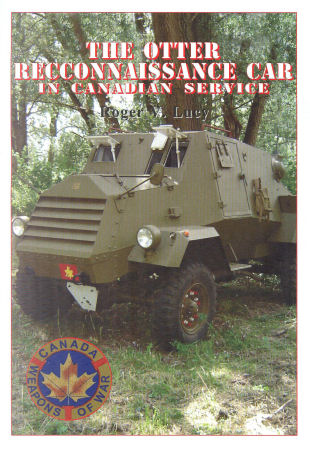
The Otter Reconnaissance Car in Canadian Service Book Review
By Cookie Sewell
| Date of Review | September 2011 | Title | The Otter Reconnaissance Car in Canadian Service |
|---|---|---|---|
| Author | Roger V. Lucy | Publisher | Service Publications |
| Published | 2011 | ISBN | 1-894581-73-8 |
| Format | 24 pages, softbound | MSRP (CDN) | $9.95 |
Review
Occasionally people make decisions in a hurry; sometimes it is out of necessity, and sometimes it basically sends others down a blind alley. When the British Army lost huge amounts of material in France, there was a panic and many hasty options were taken up to produce armored vehicles. One concept not fully thought through was the “reconnaissance car” which seemed like a good idea, but in reality was neither fish nor fowl. As the primary ones were based on passenger car frames like the Humber Snipe, they had poor off-road capability and the overweight and overtaxed chassis had reliability problems. The other problem was a lack of mission - scout cars (small two-man vehicles like the Dingo and later Lynx) carried out troop reconnaissance, and armored cars (four-man crews, armament of 15-40mm guns, and radio equipped) did more detailed reconnaissance where they were expected to fight their way out if necessary. The reconnaissance car was neither.
Even so, the Canadian Army Overseas followed British planning and decided to create reconnaissance battalions with reconnaissance cars, and so GM Canada was tasked to create on using the C8 Chevrolet 4 x 4 truck chassis as a basic. Early on two things were decided: one, the chassis was too light, so the C15 chassis was used instead, and two, the best engine for the project was the US GMC 270 cid six-cylinder engine (the same one used in the famous GMC 6 x 6 cargo trucks). Roughly based on the Humber Ironsides Mark III reconnaissance car design, th new vehicle was bigger than expected but once sorted out more reliable than its British counterparts. As the British Army had decided all vehicles must have names, and in keeping with light wheeled armored vehicles being named after animals, the new vehicle was christened as the Otter.
But the design, being based on the forlorn “reconnaissance car” scheme, had problems from the start. A two-speed transfer case was not used for reasons of weight, and the heavy Otter had problems off road. Eventually 1,009 Otters were built, and while they were not much of a success in their envisaged roles. But the chassis was reliable, and as it was roomier than some other vehicles, spur-of-the-moment conversions were made showing it to actually be fairly flexible. While the British used it primary for RAF airfield defense units, the Canadian Army applied it for convoy security, forward artillery observation posts, and other liaison functions.
The Otter did manage to serve with the Canadian Army until 1955 when no further spare parts were to be ordered to maintain them. ]
This neat little book covers the history of the Otter in great detail, and has a nice set of five-view plans in the centerfold as well as a scrap view of a turretless radio car variant. Mr. Lucy is one of the steady authors for Service and has done a nice job with this vehicle.
Overall this is a good read for wheeled armored (or armoured) vehicle buffs as well as GMC fans.
Thanks to Clive Law of Service Publications for the review copy.







